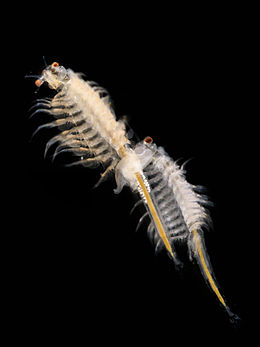A sórákok (Artemia) a levéllábú rákok (Branchiopoda) osztályának csupasz levéllábú rákok (Anostraca) rendjébe, ezen belül a sórákfélék (Artemiidae) családjába tartozó egyetlen nem.
Gyors adatok Rendszertani besorolás, Szinonimák ...
| Sórákok |
|
 |
|
| Rendszertani besorolás |
|
|
|
|
|
| Szinonimák |
- Artemesia Latrielle, 1816
- Artemia parthenogenetica Bowen & Sterling, 1978 (ez a taxon a szűznemző fajokat foglalja össze)[1]
- Artemis Thompson, 1834
- Artemisus Lamarck, 1818
- Callaonelia Kulczycki, 1885
- Eulimene Latrielle, 1816
|
|
|
|
| Hivatkozások |
|
|
Bezárás
A világ számos részén megtalálhatóak, főleg az olyan sós tavakban, ahol a sókoncentráció magas, az algaképződés fokozott, a ragadozók pedig kis számban vannak jelen vagy hiányoznak.[2][3][4][5][6] A mai fajok egy földközi-tengeri fajból fejlődtek ki, amely körülbelül 5,5 millió évvel élt ezelőtt.[7] A Genti Egyetemhez tartozó Laboratory of Aquaculture & Artemia Reference Center ezidáig 1700 állományból gyűjtött mintát.[8] Az ízeltlábúak ősi vonásait hordozzák magukon; mint például testük 19 szelvényből áll, ezekből 11 levéllábbal rendelkezik; ezek után két szelvény az ivarszerveket hordozza, míg a többiek a farkot képezik.[9] A hímek 8-10 milliméteresek, a nőstények 10-12 milliméteresek, mindkét nem pedig 4 milliméter széles. A hímek második csáppárja nagyobb, mint a nőstényeké, és ezekkel tartják maguk mellett a nőstényeket.[10] A vadonban algákkal táplálkoznak, viszont a fogságban élesztővel, búzaliszttel, szójaporral és tojássárgájával is lehet táplálni.[11][12] A nőstények majdnem minden 142 óra után tojni akarnak;[13] hímek hiányában szűznemzés is történhet.[14][15]
Ezeket a rákfajokat igen nagy számban tenyésztik a haltenyészetek számára; világszerte évente körülbelül 2000 tonnát értékesítenek belőlük.[16] Modellszervezetként számos kísérletet végeztek rajtuk; még az űrbe is kivitték néhányszor.[17][18][19]
A nembe az alábbi 7 faj tartozik:[20]
- Artemia franciscana Kellog, 1906
- Artemia monica Verrill, 1869
- Artemia persimilis Piccinelli & Prosdocimi, 1968
- sórák (Artemia salina) (Linnaeus, 1758)
- Artemia sinica Cai, 1989
- Artemia tibetiana Abatzopoulos, Zhang & Sorgeloos, 1998
- Artemia urmiana Günther, 1899
A fenti elfogadott fajok mellett, még van 10 nomen nudum is:
- Artemia americana Barrigozzi, 1974
- Artemia bivalens Artom, 1912
- Artemia cagliartiana Samter & Heymons, 1902
- Artemia elegans in Seale, 1933
- Artemia jelskii Grube, 1874
- Artemia micropirencia Artom, 1921
- Artemia odessensis Barrigozzi, 1980
- Artemia sessuata Artom, 1906
- Artemia univalens Artom, 1912
- Artemia westraliensis Sayce, 1903
Az 5 alábbi taxon név meglehet, hogy nem ebbe a nembe tartozik, nomen dubiumként szerepel:
- Artemia asiatica Walter, 1887
- Artemia australis Sayce, 1903
- Artemia eulimene Leach, 1819
- Artemia gracilis Verrill, 1869 (meglehet, hogy az A. francisana Kellogg, 1906 szinonimája)
- Artemia köppeniana Fischer, 1851
Artemia franciscana
Artemia monica
Artemia persimilis
(2008. december 1.) „Structural changes of Artemia parthenogenetica (Bowen and Sterling, 1978) (Branchiopoda-Anostraca) exposed to lead acetate”. Food and Chemical Toxicology 46 (12), 3770–3773. o. DOI:10.1016/j.fct.2008.09.060. Whitey Hitchcock: Brine shrimp. Clinton High School Science. [2010. szeptember 3-i dátummal az eredetiből archiválva]. (Hozzáférés: 2010. március 13.) Martin Daintith. Rotifers and Artemia for Marine Aquaculture: a Training Guide. University of Tasmania (1996). OCLC 222006176 F. A. Abreu-Grobois. A review of the genetics of Artemia, Artemia Research and its Applications. Proceedings of the Second International Symposium on the Brine Shrimp Artemia, organised under the patronage of His Majesty the King of Belgium. Wetteren, Belgium: Universa Press, 61–99. o. (1987). OCLC 17978639 De Vos, Stephanie. Genomic tools and sex determination in the extremophile brine shrimp Artemia franciscana. Ghent: UGent, 3. o. (2014). ISBN 9789059897175 (1980) „Scanning electron microscopy of the frontal knobs of the male brine shrimp”. Transactions of the American Microscopical Society 99 (2), 167–172. o. JSTOR 3225702. Artemia morphology and structure, Artemia: Basic and Applied Biology. Kluwer Academic Publishers, 1–33. o. (2002). ISBN 978-1-4020-0746-0 (1992) „The use of Artemia salina in toxicity testing”. Alternatives to Laboratory Animals 20, 297–301. o.
The effects of cosmic rays on Artemia egg cysts, Report for National Aeronautics and Space Administration. Toulouse, France: Faculté de Médcine (1980)
- Ez a szócikk részben vagy egészben a Brine shrimp című angol Wikipédia-szócikk ezen változatának fordításán alapul. Az eredeti cikk szerkesztőit annak laptörténete sorolja fel. Ez a jelzés csupán a megfogalmazás eredetét és a szerzői jogokat jelzi, nem szolgál a cikkben szereplő információk forrásmegjelöléseként.
- Artemia Leach, 1819 WoRMS
- Brine Shrimp and Ecology of Great Salt Lake
- Genus Artemia'. Systema Naturae 2000. The Taxonomicon. [2010. március 13-i dátummal az eredetiből archiválva]. (Hozzáférés: 2010. március 13.)
- Richard Fox: 'Artemia Laboratory Exercise – Artemia franciscana', 2004. február 13. [2006. április 23-i dátummal az eredetiből archiválva]. (Hozzáférés: 2010. március 13.)
- Brine Shrimp and Ecology of Great Salt Lake. United States Geological Survey, 2009. május 15. (Hozzáférés: 2010. március 13.)
- Aqua Dragons, commercial site.
- Abatzopoulos, T.J.; Zhang, B.; Sorgeloos, P. 1998: Artemia tibetiana: preliminary characterization of a new Artemia species found in Tibet (People's Republic of China). International Study on Artemia. 59. International journal of salt lake research, 7(1): 41–44. [not seen]
- Asem, A.; Rastegar-Pouyani, N.; De Los Ríos-Escalante, P. 2010: The genus Artemia Leach, 1819 (Crustacea: Branchiopoda). I. True and false taxonomical descriptions. Latin American journal of aquatic research, 38(3): 501–506. doi:10.3856/vol38-issue3-fulltext-14 [doi broken/unregistered] PDF
- Eimanifar, A., Asem, A., Djamali, M. & Wink, M. 2016. A note on the biogeographical origin of the brine shrimp Artemia urmiana Günther, 1899 from Urmia Lake, Iran. Zootaxa 4097(2): 294–300. doi: 10.11646/zootaxa.4097.2.12. reference page
- Mura, G.; Gajardo, G. 2011: The highly divergent New World Artemia species (Branchiopoda, Anostraca), A. franciscana and A. persimilis, show subtle differences in morphological traits involved in mating. Zootaxa 2912: 37–48. Preview reference page
